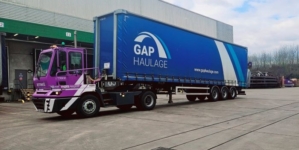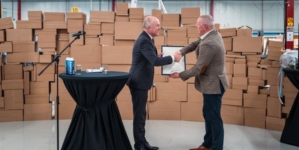-
Nutrivend selects Forterro’s Orderwise to support online expansion and streamline operations - April 11, 2025
-
ARROWXL LAUNCHES AMBITIOUS ZERO WASTE ROADMAP - April 8, 2025
-
THE BCMPA’S NEW CAMPAIGN DRIVES OUTSOURCING SUCCESS IN Q1 - April 7, 2025
-
BLACKOUT TECHNOLOGIES TARGETS TELEMATICS-INTEGRATED MOBILE DEVICE BLOCKING TO COMBAT SMARTPHONE DISTRACTION - April 1, 2025
-
Sparck Technologies awarded Royal designation - March 27, 2025
-
OpenADR Alliance announces first OpenADR 3.0 certified products with EVoke Systems, E.ON Energy and Universal Devices - March 25, 2025
-
Growing fulfilment and contract packer appoints new Managing Director - March 25, 2025
-
When is it time to invest in a WMS? Understanding the key trigger points - March 25, 2025
-
eCapital helps Vantage Recruitment on its journey to financial success - March 24, 2025
-
Hugo Beck Celebrates 70 Years of Packaging Innovation with Open House Events - March 20, 2025
Are your warehousing costs much higher than they should be?
Learn how Indigo’s Phase Zero delivers on McKinsey’s ‘bottom-up’ best practice to lower warehousing costs
Cost reduction is consistently among the top ten supply chain goals for companies who need to find ways to recoup eroding margins as a result of increasing competition. But as research by McKinsey has highlighted, whilst companies know what their costs are – as in, what they are spending – very few actually know what their true costs should be. This is what Indigo describes as the ‘cost to serve’ and it is the minimum expenditure required to operate the warehouse and logistics functions. There can be a huge difference between these two figures.
McKinsey estimates that worldwide, warehousing operations cost companies about €300 billion each year, which is expected to grow as supply chains lengthen globally and the complexity of eCommerce increases. Problems arise because many businesses lack a formal methodology for analysing their warehouse processes and costs, with the outcome that thousands are running facilities at a significantly higher cost than they should be. Using a 3PL can be a red herring, because although this will clarify the cost to outsource warehousing, it is unlikely to be equivalent to the ‘cost to serve’.
Without knowing what the minimum running costs for a specific warehouse should be, initiatives to reduce spending and increase efficiency are unlikely to be successful. The same is true when implementing new technology. A recent global research study found 80% of companies intend to invest in new warehouse technology as part of their strategy to become more competitive and reduce costs, with 60% reporting challenges due to inadequate labour efficiency and productivity as a key driver.
Prior to any project, it is essential to identify how existing processes can be improved before the addition of new technology. Otherwise, warehouse managers will be unable to measure the true gains that can be achieved. McKinsey recommends companies do this through a bottom up analysis based on using ‘cleansheets’ to determine the ideal cost structure for a given facility, rather than conduct an initial benchmarking exercise which tends to be top down and lacking in granular detail.
As Indigo has established, whilst companies in the same industries share commonalities, every warehouse is unique, with different product portfolios, order patterns, delivery standards and supply-chain requirements. As a mathematical model, a cleansheet provides a way to determine the true costs for any given warehouse, in terms of warehouse space utilisation, labour costs / processes and materials handling equipment in a structured way. These are typically the three largest cost centres in any warehousing facility. By identifying the lowest possible cost for each of these and then comparing it with the actual cost the company is now paying, it is possible to tackle the biggest discrepancies and problem areas, answering questions like:
· What is the most efficient way to process incoming and outgoing goods?
· How much time should be spent on each warehouse management activity?
· How can existing resources be used more efficiently?
McKinsey’s recommendations exactly match Indigo’s approach when working with manufacturers and retailers. When visiting new warehouse management system (WMS) software customers for the first time, Indigo finds that many don’t actually know why they run their operations in the way they do. Frequently, their warehouse processes will have evolved over many years. Many are therefore unsure what the optimum performance should be or which changes to introduce, in order to achieve improvements.
During project Phase Zero, Indigo’s supply chain consulting team does exactly this, exploring what changes they should make to operations before implementing a WMS. These changes may be to organisational structure and roles / responsibilities or to the detail of business processes, for instance to picking and replenishment tasks. Indigo’s approach is to consider, if there were no resourcing issues or software constraints, how best would the warehouse operate? These changes must be made in advance of any software implementation and every project has its own demands and requirements.
Indigo works in line with McKinsey best practice in our Phase Zero projects to examine current processes and look for opportunities. In one recent Phase Zero initiative, Indigo identified that order picking could be optimised with wave picking before introducing a WMS, thereby allowing for greater savings to be achieved post implementation. At the same customer, we have helped them optimise transport planning processes, by reviewing decision making to make selections more cost efficient. By focusing on ‘path clearers’ and conducting our own cleansheet analysis, Indigo has helped to ready this customer’s warehouse for its Indigo WMS implementation.
Almost without exception, Indigo encounters very few businesses that understand their cost to serve. They know their costs, overheads and sales revenues and they might know the difference between warehousing and transport costs, but they have no idea how it is built up and how to improve it. Yet with expert support and guidance, it is such a straightforward problem to resolve and deliver real efficiency cost savings for the business.
Author: Mark Wilkinson, Supply Chain Consultancy Manager, Indigo Software
































